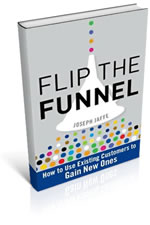“Never before in the history of business and marketing has customer service been as front and center as it is today”. That’s how Joseph Jaffe’s, Customer Service Manifesto’ starts.
Jaffe, published the manifesto “in association with ‘Flip the Funnel’” (his new book). I went through the manifesto. Here are some first takeaways.
Let’s start with some underlying ideas from Joe’s manifesto. Joseph Jaffe bases his whole manifesto on one hypothesis: “that customer service needs to be elevated to the front office; to that of a strategic imperative which becomes a, if not the, key differentiator in the board room and beyond”.

Isn’t customer service too specific and “narrow” to be attributed such significance? First of all, it depends on how you define it. When you read the words “customer service”, you might see the image of an inbound contact center where people pick up the phone to answer questions from disgruntled or “lost” customer. You might also think about online self service systems. But you can also see the bigger picture. Taste the words again: “customer service”. Customer. And service.
Everyone is a customer
We know that people decide how, where and when they connect with you. We also know the increasing importance of social media, the shift of several phases in the buying cycle towards online channels and word-of-mouth (which is not new at all but has found new, fast and borderless ways via digital channels),
We also have seen many examples where big businesses lost brand value, customer trust and revenue because they failed to listen to the concerns and questions of their customers who made their dissatisfaction public and now and then could bring “a mighty corporate behemoth to its knees” as Jaffe puts it. Joseph writes that probably the “most important issue business and marketing execs will need to come to terms with in 2010 and beyond is how to create an organization that is mobilized, structured and empowered to be responsive, empathetic, accessible, connected and human in the hearts, minds, and wallets of their most prized assets—their customers and their employees”.
For me, that distinction between customers and employees wasn’t even necessary: your employees and all other partners in the ecosystem of your business (vendors, press, etc.) are your customers and to make your customers happy you need to know what makes them “sell” to their customers.
Joseph realizes that customer service is “just one component of a much broader customer experience imperative”.
However, then why is it so important? Because, and I quote again, “it is the most tangible, impactful and actionable item in your portfolio of services that you can activate in a truly transformative manner”. But this does not mean that Joseph looks at customer service in the way we have learned to see it (solving problems, FAQ’s, the call center I mentioned earlier, etc.). On the contrary: he writes that customer service is not only about solving problems, but that it needs to be proactive, can be a revenue generator and that it is even the new marketing and PR, as we’ll see in a follow-up post.
[blockquote author=”Joseph Jaffe”]An unhappy customer will tell a million of their closest strangers[/blockquote]Give value to get value back
In human relationships, there is often an inequality between what you get, and what you give. It depends from the relationship and the person you are, I guess. But there is a “quid pro quo” aspect in most relationships. In business relationships this is even truer. People are not doing business with each other just because they care for each other (or let’s say that it’s rare).
Back to Joseph Jaffe’s Manifesto. He writes: “Loving thy neighbor has always made good sense. Having a customer that loves you back in return makes for good business sense”. But, strangely enough, these basic facts (what I call ‘give value to get value’) are not implemented very well. Maybe, as Jaffe says, we have to blame technology, or rather the way we have used technology by thinking these principles could be fully automated.
Meanwhile, Jaffe writes, what we see is connectedness, social networks, word-of-mouth and a “growing distrust and dissatisfaction with corporations”.
The key takeaway here, however, is, and I quote “The old marketing adage is that a satisfied customer will tell 5-7 of their friends about their experience, whereas the dissatisfied customer will tell 15-20. Today, an unhappy customer will tell a million of their closest strangers.”
You knew that. But think it through.
Beyond the Customer Service Manifesto: marketing efficiency 101
The importance of excellent customer service across all touchpoints is not just one of WOM. It goes much further than that. It’s about the simple fact that a focus on optimizing customer experiences, focussing on retention and loyalty, since long before social media arrived, simply brings in more cash. You reduce churn, you spend less (acquisition is expensive) and you shorten the buying cycle. That’s marketing 101.
Imagine what this means in this more connected and shifting customer reality. Focus on experiences, existing customers, conversion (the obvious result of customer-centric optimization) and Key Account Management and loyalty more than ever before. More long-term, less short-term. And if short-term is needed: don’t ignore long-term.

